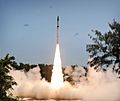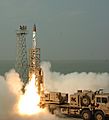Abdul Kalam Island facts for kids
|
Location of Abdul Kalam Island in Odisha, India
|
|
| Geography | |
|---|---|
| Location | Bay of Bengal |
| Coordinates | 20°45′28″N 87°05′02″E / 20.75778°N 87.08389°E |
| Area | 390 acres (160 ha) |
| Length | 2 km (1.2 mi) |
| Administration | |
| State | Odisha |
| District | Bhadrak |
Dr. Abdul Kalam Island, once known as Wheeler Island, is a special island off the coast of Odisha, India. It's about 150 kilometers (93 miles) east of Bhubaneswar, the state capital.
The island was first named after a British officer, Lieutenant Hugh Wheeler. But on September 4, 2015, it was renamed to honor Dr. A. P. J. Abdul Kalam. He was a very respected former president of India and a famous scientist.
This island is super important because it's home to the Integrated Test Range. This is a special place where India tests many of its missiles. Some of the missiles tested here include the Akash, Agni, BrahMos, and Prithvi.
Contents
Where is Abdul Kalam Island?
Abdul Kalam Island is one of five islands in the Bay of Bengal. It's about 10 kilometers (6 miles) from India's eastern coast. It's also about 70 kilometers (43 miles) south of Chandipur in the Balasore district of Odisha.
The island is about 2 kilometers (1.2 miles) long. Its total area is about 390 acres (1.6 square kilometers). The closest port is Dhamra Port. The island is part of the Bhadrak district.
What is the Integrated Test Range?
The Integrated Test Range (ITR) is a facility used for testing missiles. It has two main parts. One part, called Launch Complex-IV (LC-IV), is on Abdul Kalam Island. The other part, Launch Complex-III (LC-III), is located at Chandipur.
How the Island Became a Test Site
In the early 1980s, the Indian government started looking for a good place to test its military missiles. They especially wanted to test the Agni series of missiles. The Defence Research and Development Organisation (DRDO) set up a temporary testing site near Chandipur.
In 1986, the government planned to build a large test range in Baliapal. This would have meant moving many people from their homes. However, this plan was later dropped. Instead, in 1995, a new test site called Launch Complex-IV was built on Abdul Kalam Island.
Dr. A. P. J. Abdul Kalam played a big role in this. He became the first director of the Integrated Test Range in 1982. After a successful test of the Prithvi missile in 1993, the Indian Army wanted another test on land. They wanted to be sure about the missile's accuracy.
Dr. Kalam and his team looked for an uninhabited island off India's east coast. They found three small islands on a map. These were called Long Wheeler, Coconut Wheeler, and Small Wheeler.
Scientists Dr. V. K. Saraswat and Dr. S.K. Salwan went to find these islands. They hired a boat and used a compass. They got a bit lost but found some fishermen who told them about an island called "Chandrachood." This turned out to be the same as Small Wheeler island on the map. It was perfect for a missile testing facility. The scientists even had to spend a night there, eating only bananas!
Dr. Kalam got permission from the government to use the island. He wrote to the Chief Minister of Odisha, Biju Patnaik, asking for the islands. Chief Minister Patnaik agreed to give all five islands to DRDO for free. He asked Dr. Kalam to promise that India would build a missile that could reach China. Dr. Kalam agreed, and the Odisha government leased the islands to DRDO for 99 years. Dr. Kalam often called the island his "Theatre of Action."
The first missile test on Abdul Kalam Island was the Prithvi missile on November 30, 1993. It was a huge success, hitting its target with amazing accuracy. A special memorial called Prithvi Point now stands where the missile landed.
Abdul Kalam Island was empty when DRDO got it. Now, only DRDO staff and Defence Ministry officials are allowed on the island. It's usually quiet, with only security staff. But during missile tests, thousands of scientists and technicians come to work there.
The island has special buildings for assembling and checking missiles. It also has a launch pad. You can only get to the island by ship, as there's no airport or bridge. However, it does have a small helipad. There's even a 2.3-kilometer (1.4-mile) railway line. This railway helps carry missile parts from the pier to the launch pad. The island also has places for scientists and staff to live.
Protecting Nature on the Island
Abdul Kalam Island is very close to the Gahirmatha Marine Sanctuary. This sanctuary is the world's largest nesting place for the endangered olive ridley sea turtle. The sandy beaches of Abdul Kalam Island are also a favorite spot for these turtles to lay their eggs.
The bright lights from the missile testing facility used to confuse baby turtles. They would get lost and not find their way to the sea, and some would die. To protect these turtles, all the lights at the facility are now dimmed or covered during nesting season. Missile testing is also stopped during the turtles' nesting and breeding time.
The DRDO says that many olive ridley turtles lay eggs on the island's beaches. In February-March 2013, about 150,000 turtles laid eggs there, and their numbers are growing.
Scientists are also watching the island's shape. Since it's a sandy area, the sea can cause the sand to move around. Experts are helping to keep an eye on this.
Gallery
See also
 In Spanish: Isla Wheeler para niños
In Spanish: Isla Wheeler para niños





